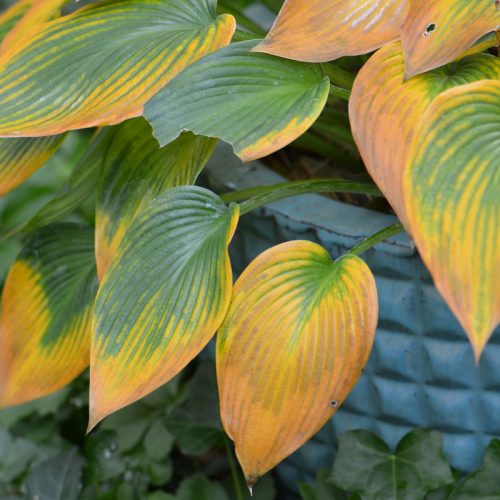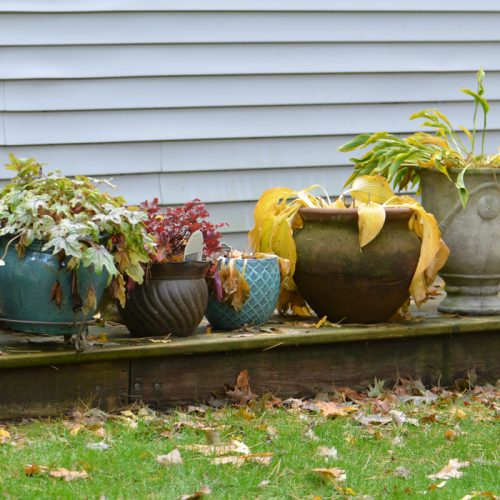Can you keep perennials in pots over winter? As it has become more popular every year to grow perennials and dwarf shrubs in containers, we are asked often about how to overwinter those plants. There are a few options to try, so choose the one that works best for your garden.

Option 1: Plant them temporarily in the ground.
Plants growing in containers get colder in the winter than those growing in the ground because they are far less insulated. Whenever possible, we recommend that you overwinter your perennials and shrubs in the ground. You could plant them in a temporary location in the garden just for the winter months and then replant them in your containers in early spring, or you could bury the entire pot in the ground and lift it back out in spring.
Option 2: Use the huddle method outdoors.
Maybe you have a grouping of plants that didn’t get planted this year, or maybe you’re intentionally growing some perennials and shrubs in containers. One way to overwinter them outdoors is to huddle them all together tightly, pot to pot, up against a fence or under the eaves against your house or garage. Once the plants have gone dormant, pile leaves or mulch over them completely—pots and all. This will help to insulate them over the winter. Be sure to unbury them in early spring to allow the plants to resprout.
Option 3: Bring your potted plants into an unheated garage or shed for winter.
Plants stored under cover should stay at least a few degrees warmer than those exposed to the elements outdoors, and that small difference will make it easier on your plants over winter. If your garage has a window, consider setting a table near it and placing any potted evergreen plants on it that you are overwintering. They will need some light in winter even though they are not actively growing. If the plants you are overwintering in containers go completely dormant in winter, they will not need any light.
Whether you choose the huddle method or overwinter your plants in a garage or shed, you will need to take some precautions to prevent rodent damage. If you were a mouse or vole, you’d love to spend the winter in a relatively warm garage or shed in a comfy pot of soil, too. The trouble comes when they eat the roots or crown of the plant, or when they disturb the soil so much that cold air pockets settle in around the roots. It’s a good idea to bait for or trap rodents wherever you are overwintering your plants.

Here are a few more questions we are frequently asked about overwintering plants in containers.
Do I need to water the plants I am storing over the winter?
Your plants will need very little water while they are dormant, but you don’t want them to completely dry out either, especially if they are evergreen. What works well in the North is adding a layer of snow on top of your pots about once a month in winter and letting it melt slowly over time. If you live someplace where it doesn’t snow much in winter (lucky you!), use a watering can instead.
How cold is too cold?
Bitter cold temperatures can hurt your containerized plants over winter, but most perennials and shrubs do benefit from some cold exposure. Here are a few helpful rules of thumb to follow.
- Choose a plant that is at least two zones hardier than your zone for overwintering in a container. For example, if you garden in zone 7, choose a perennial or shrub that is hardy at least to zone 5. Though some sources claim that one zone is sufficient, some plants are more cold sensitive than others and two zones hardier is a much safer bet.
- The bigger and heavier the pot, the better the chances of overwintering success. Insulation is key in protecting the root ball of the plant you are trying to overwinter. A large, thick-walled ceramic pot offers far greater protection than a smaller, thin-walled plastic pot. Bigger containers also hold more soil which acts as an insulator.
- Cold is good for your perennials and shrubs. Do not bring them into someplace warm for winter. Your goal should be to keep them dormant all winter once they drop their leaves. You want your perennials and shrubs to sleep soundly until spring arrives. If there is a warm spell in the middle of winter and they start to leaf out again, they may be damaged when the cold winter temperatures return.
Can I leave my ceramic pot outside for winter?
The answer to this question depends on where you live. If you live in the North where you’ll have freezing temperatures all winter long, the answer is no. If you live in the South where it never freezes, the answer is yes.
Freezing and thawing cycles can easily break terra cotta pots apart and can even bust open thicker walled glazed containers. This is especially true when the soil in the container is moist. Containers labeled “frost resistant” are a denser fired clay that is less prone to absorbing the moisture that breaks them apart, but they aren’t foolproof. If you really like that pot, it’s best to bring it under cover for winter. If it’s too big to move, consider emptying it and laying it on its side or upside down for winter.
Looking for more winter gardening advice? Check out these tips.

1 thought on “Can I overwinter this hardy plant in a container?”
Thanks for the information